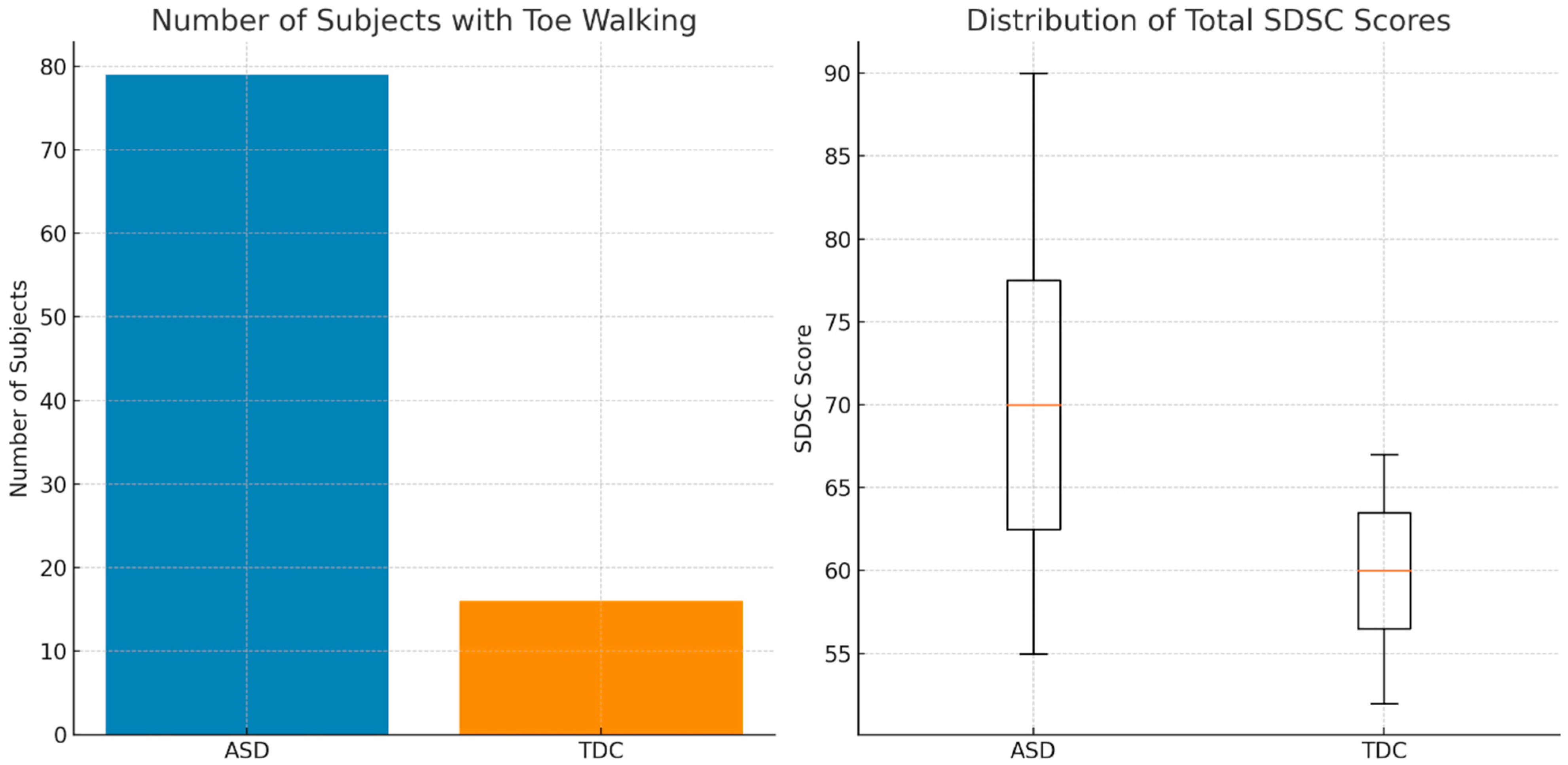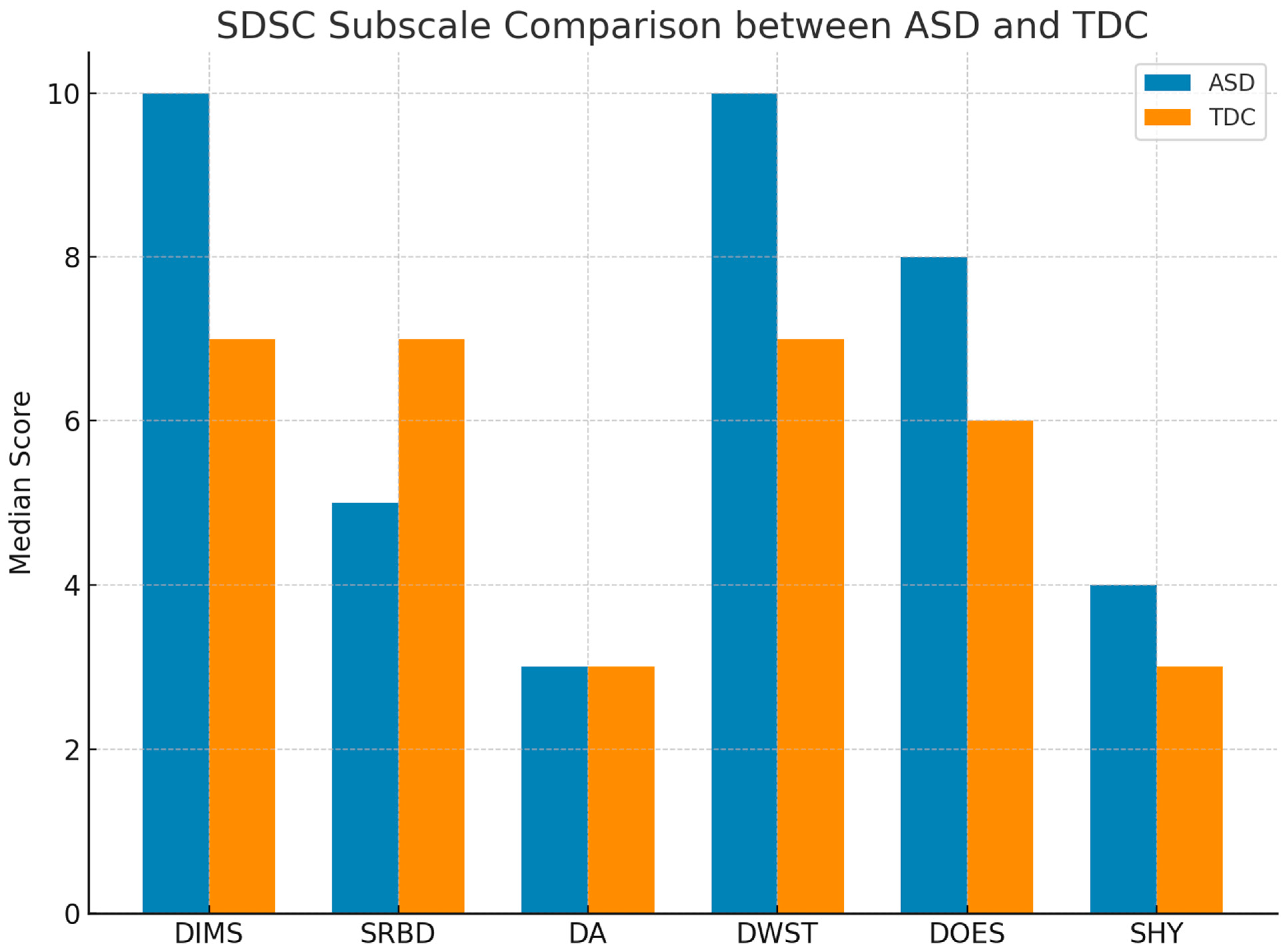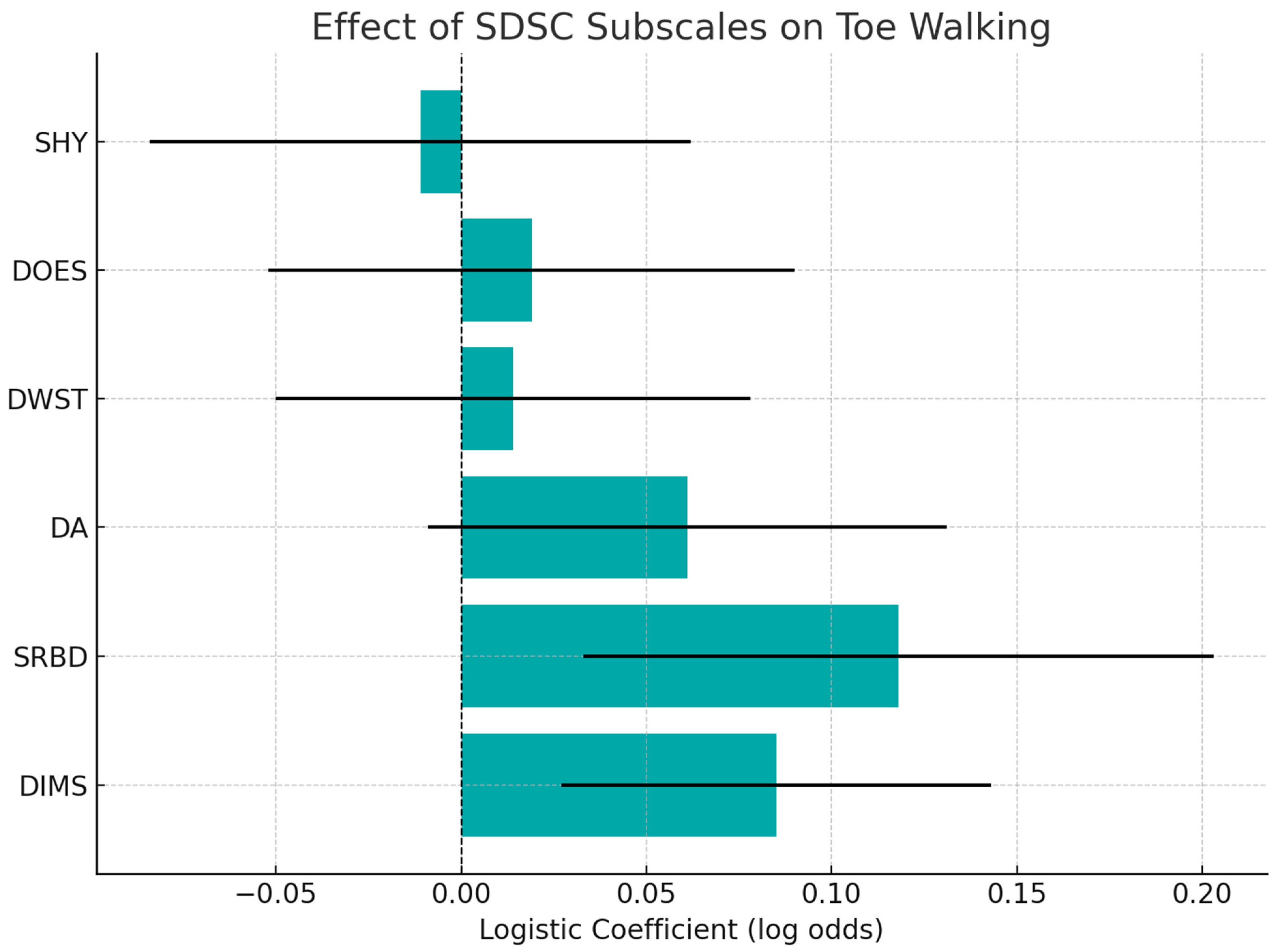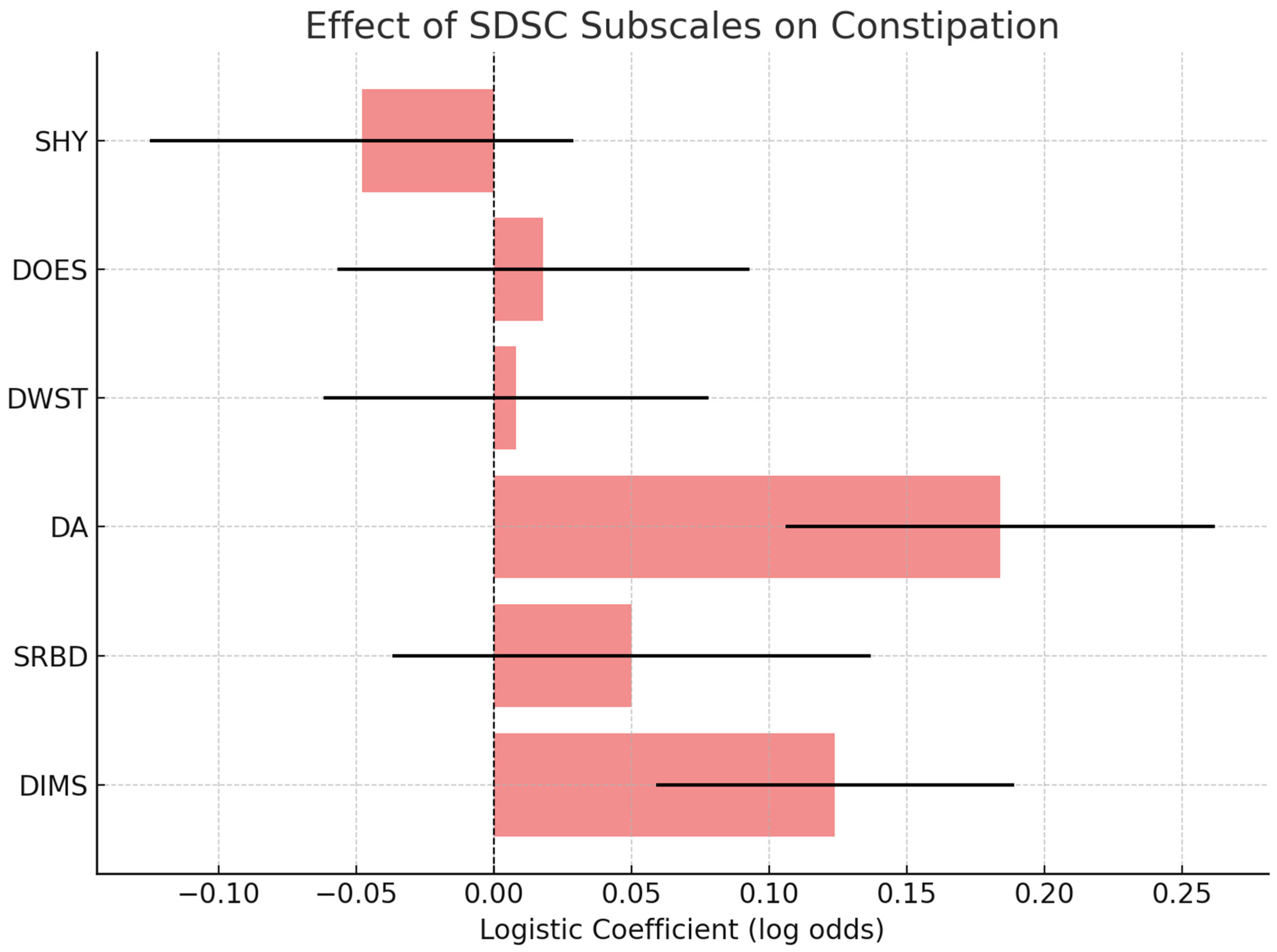The Prevalence and Clinical Significance of Toe Walking in Autism Spectrum Disorder: A Cross-Sectional Study in an Italian Pediatric Sample
Abstract
1. Introduction
2. Materials and Methods
2.1. Ethical Statement
2.2. Population
2.3. Sleep Disturbance Scale for Children (SDSC)
2.4. Brief Autism Mealtime Behavior Inventory (BAMBI)
2.5. Statistical Analysis
3. Results
3.1. SDSC Subscale Comparison
3.2. TW and SDSC Regression
3.3. Constipation Regression
4. Discussion
Limitations
5. Conclusions
Author Contributions
Funding
Institutional Review Board Statement
Informed Consent Statement
Data Availability Statement
Acknowledgments
Conflicts of Interest
References
- American Psychiatric Association. Diagnostic and Statistical Manual of Mental Disorders, 5th ed.; American Psychiatric Association: Washington, DC, USA, 2013; ISBN 978-0-89042-555-8. [Google Scholar]
- Engström, P.; Tedroff, K. The Prevalence and Course of Idiopathic Toe-Walking in 5-Year-Old Children. Pediatrics 2012, 130, 279–284. [Google Scholar] [CrossRef]
- Clark, E.; Sweeney, J.K.; Yocum, A.; McCoy, S.W. Effects of Motor Control Intervention for Children with Idiopathic Toe Walking: A 5-Case Series. Pediatr. Phys. Ther. 2010, 22, 417–426. [Google Scholar] [CrossRef]
- Adeniyi, Y.C.; Adeniyi, A.F.; Oyewole, O.A. Toe Walking in Children with Autism Spectrum Disorder and Comorbid Attention Deficit Hyperactivity Disorder: An Early Marker of a Heterogeneous Disorder? Indian J. Case Rep. 2020, 6, 481–484. [Google Scholar] [CrossRef]
- Donne, J.H.; Powell, J.A.; Fahey, M.C.; Beare, R.; Kolic, J.; Williams, C.M. Some Children with Idiopathic Toe Walking Display Sensory Processing Difficulties but Not All: A Systematic Review. Acta Paediatr. 2023, 112, 1620–1632. [Google Scholar] [CrossRef]
- Serdarevic, F.; Ghassabian, A.; van Batenburg-Eddes, T.; White, T.; Blanken, L.M.E.; Jaddoe, V.W.V.; Verhulst, F.C.; Tiemeier, H. Infant Muscle Tone and Childhood Autistic Traits: A Longitudinal Study in the General Population. Autism Res. 2017, 10, 757–768. [Google Scholar] [CrossRef] [PubMed]
- Esposito, G.; Paşca, S.P. Motor Abnormalities as a Putative Endophenotype for Autism Spectrum Disorders. Front. Integr. Neurosci. 2013, 7, 43. [Google Scholar] [CrossRef] [PubMed]
- Anzulewicz, A.; Sobota, K.; Delafield-Butt, J.T. Toward the Autism Motor Signature: Gesture Patterns during Smart Tablet Gameplay Identify Children with Autism. Sci. Rep. 2016, 6, 31107. [Google Scholar] [CrossRef] [PubMed]
- Crippa, A.; Salvatore, C.; Perego, P.; Forti, S.; Nobile, M.; Molteni, M.; Castiglioni, I. Use of Machine Learning to Identify Children with Autism and Their Motor Abnormalities. J. Autism Dev. Disord. 2015, 45, 2146–2156. [Google Scholar] [CrossRef]
- Torres, E.B.; Brincker, M.; Isenhower, R.W.; Yanovich, P.; Stigler, K.A.; Nurnberger, J.I.; Metaxas, D.N.; José, J.V. Autism: The Micro-Movement Perspective. Front. Integr. Neurosci. 2013, 7, 32. [Google Scholar] [CrossRef]
- Ganai, U.J.; Ratne, A.; Bhushan, B.; Venkatesh, K.S. Early Detection of Autism Spectrum Disorder: Gait Deviations and Machine Learning. Sci. Rep. 2025, 15, 873. [Google Scholar] [CrossRef]
- Accardo, P.J.; Barrow, W. Toe Walking in Autism: Further Observations. J. Child Neurol. 2015, 30, 606–609. [Google Scholar] [CrossRef]
- Chapek, M.; Kessler, J. The Prevalence of Persistent Toe Walking in Children With and Without Autism Spectrum Disorder and the Odds of Subsequent Surgery. J. Foot Ankle Surg. 2025, 64, 16–20. [Google Scholar] [CrossRef]
- Valagussa, G.; Trentin, L.; Signori, A.; Grossi, E. Toe Walking Assessment in Autism Spectrum Disorder Subjects: A Systematic Review. Autism Res. 2018, 11, 1404–1415. [Google Scholar] [CrossRef] [PubMed]
- Camia, M.; Sacco, R.; Boncoddo, M.; Bellomo, F.; Cucinotta, F.; Ricciardello, A.; Turriziani, L.; Tomaiuolo, P.; Costantini, R.C.; D’Amico, R.; et al. Toe Walking in Children and Adolescents with Autism Spectrum Disorder: Relationship with Sensory and Motor Functions, Language, Cognition, and Autism Severity. Res. Autism Spectr. Disord. 2024, 117, 102457. [Google Scholar] [CrossRef]
- Leyden, J.; Fung, L.; Frick, S. Autism and Toe-Walking: Are They Related? Trends and Treatment Patterns between 2005 and 2016. J. Child. Orthop. 2019, 13, 340–345. [Google Scholar] [CrossRef] [PubMed]
- Shetreat-Klein, M.; Shinnar, S.; Rapin, I. Abnormalities of Joint Mobility and Gait in Children with Autism Spectrum Disorders. Brain Dev. 2014, 36, 91–96. [Google Scholar] [CrossRef]
- Barrow, W.J.; Jaworski, M.; Accardo, P.J. Persistent Toe Walking in Autism. J. Child Neurol. 2011, 26, 619–621. [Google Scholar] [CrossRef]
- Williams, C.M.; Tinley, P.; Curtin, M.; Wakefield, S.; Nielsen, S. Is Idiopathic Toe Walking Really Idiopathic? The Motor Skills and Sensory Processing Abilities Associated with Idiopathic Toe Walking Gait. J. Child Neurol. 2014, 29, 71–78. [Google Scholar] [CrossRef]
- Williams, C.M.; Tinley, P.; Rawicki, B. Idiopathic Toe-Walking: Have We Progressed in Our Knowledge of the Causality and Treatment of This Gait Type? J. Am. Podiatr. Med. Assoc. 2014, 104, 253–262. [Google Scholar] [CrossRef]
- Chu, V.; Girolami, G.L.; Grant-Beuttler, M. Assessing Sensory Processing Differences in Children with Idiopathic Toe Walking: A Pilot Study. Physiother. Theory Pract. 2023, 39, 2314–2326. [Google Scholar] [CrossRef]
- Zide, J.R.; Riccio, A.I.; Zak, T.; Minopoli, A.; Polk, J.L.; Shivers, C. Recurrent Toe Walking in Pediatric Orthopedic Patients: Idiopathic vs Concomitant Sensory Processing Disorders. Foot Ankle Orthop. 2023, 8, 2473011423S00189. [Google Scholar] [CrossRef]
- Memari, A.H.; Ghanouni, P.; Shayestehfar, M.; Ghaheri, B. Postural Control Impairments in Individuals With Autism Spectrum Disorder: A Critical Review of Current Literature. Asian J. Sports Med. 2014, 5, e22963. [Google Scholar] [CrossRef]
- Manfredi, F.; Riefoli, F.; Coviello, M.; Dibello, D. The Management of Toe Walking in Children with Autism Spectrum Disorder: “Cast and Go”. Children 2022, 9, 1477. [Google Scholar] [CrossRef]
- Gigliotti, F.; Giovannone, F.; Belli, A.; Sogos, C. Atypical Sensory Processing in Neurodevelopmental Disorders: Clinical Phenotypes in Preschool-Aged Children. Children 2024, 11, 875. [Google Scholar] [CrossRef] [PubMed]
- Savarese, G.; Mandia, R.; Diavoletto, A.; Piscitelli, M.; Impemba, F.; Di Siervi, A.; Carpinelli, L.; Bottiglieri, F.; Sessa, M.; Corrivetti, G. Preliminary Results of Sensorimotor Room Training for the Improvement of Sensory and Motor Skills in Children with Autism Spectrum Disorders. Pediatr. Rep. 2025, 17, 4. [Google Scholar] [CrossRef] [PubMed]
- Bruni, O.; Biggio, G.; Malorgio, E.; Nobili, L. Insomnia in Children Affected by Autism Spectrum Disorder: The Role of Melatonin in Treatment. Sleep Med. 2024, 119, 511–517. [Google Scholar] [CrossRef] [PubMed]
- Voci, A.; Mazzone, L.; De Stefano, D.; Valeriani, M.; Bruni, O.; Moavero, R. Restless Sleep Disorder in a Sample of Children and Adolescents with Autism Spectrum Disorder: Preliminary Results from a Case Series. J. Clin. Sleep Med. 2024, 20, 427–432. [Google Scholar] [CrossRef]
- Socie, C.; Descamps, A.; Thouvenin, B.; du Fraysseix Peigné, C.; Abadie, V.; Ouss, L. Eating Disorders in Children under 4 Years of Age with Autism Spectrum Disorder: Description and Determinants: Eating Disorders in Children with Autism Spectrum Disorder. Arch. Pediatr. 2025, 32, 255–260. [Google Scholar] [CrossRef]
- Sharp, W.G. Systematic Reviews on Eating Disorders and Autism Spectrum Disorder Emphasize a Call to Further Expand High-Quality Research. Int. J. Eat. Disord. 2025, 58, 168–170. [Google Scholar] [CrossRef]
- Młynarska, E.; Barszcz, E.; Budny, E.; Gajewska, A.; Kopeć, K.; Wasiak, J.; Rysz, J.; Franczyk, B. The Gut–Brain–Microbiota Connection and Its Role in Autism Spectrum Disorders. Nutrients 2025, 17, 1135. [Google Scholar] [CrossRef]
- Morton, J.T.; Jin, D.-M.; Mills, R.H.; Shao, Y.; Rahman, G.; McDonald, D.; Zhu, Q.; Balaban, M.; Jiang, Y.; Cantrell, K.; et al. Multi-Level Analysis of the Gut–Brain Axis Shows Autism Spectrum Disorder-Associated Molecular and Microbial Profiles. Nat. Neurosci. 2023, 26, 1208–1217. [Google Scholar] [CrossRef]
- Adams, J.B.; Johansen, L.J.; Powell, L.D.; Quig, D.; Rubin, R.A. Gastrointestinal Flora and Gastrointestinal Status in Children with Autism-Comparisons to Typical Children and Correlation with Autism Severity. BMC Gastroenterol. 2011, 11, 22. [Google Scholar] [CrossRef]
- Tao, X.; Li, Z.; Wang, D.; Pu, J.; Liu, Y.; Gui, S.; Zhong, X.; Yang, D.; Zhou, H.; Tao, W.; et al. Perturbations in Gut Microbiota in Autism Spectrum Disorder: A Systematic Review. Front. Neurosci. 2025, 19, 1448478. [Google Scholar] [CrossRef]
- Hu, D.-X.; Lu, C.-M.; Si, X.-Y.; Wu, Q.-T.; Wu, L.-H.; Zhong, H.-J.; He, X.-X. Effects of Gastrointestinal Symptoms on the Efficacy of Washed Microbiota Transplantation in Patients with Autism. Front. Pediatr. 2025, 13, 1528167. [Google Scholar] [CrossRef]
- Mignolli, E.; Scialpi, A.; Valente, D.; Berardi, A.; Galeoto, G.; Tofani, M. Sleep Disturbance Scale for Children: Italian Validation in Autism Spectrum Disorder Population. Int. J. Environ. Res. Public Health 2022, 19, 10163. [Google Scholar] [CrossRef]
- Lamboglia, A.; Romano, R.; Valente, D.; Berardi, A.; Cavalli, G.; Giovannone, F.; Sogos, C.; Tofani, M.; Galeoto, G. Brief Autism Mealtime Behavior Inventory (BAMBI): Italian Translation and Validation. Children 2023, 10, 1201. [Google Scholar] [CrossRef] [PubMed]
- Lukens, C.T.; Linscheid, T.R. Development and Validation of an Inventory to Assess Mealtime Behavior Problems in Children with Autism. J. Autism Dev. Disord. 2008, 38, 342–352. [Google Scholar] [CrossRef] [PubMed]
- Będziechowska-Czyżewska, M.; Malak, R.; Romanowski, M.; Andrusiewicz, M.; Samborski, W.; Baum, E. Postural Differences in Speaking Versus Non-Speaking Children with Autism Spectrum Disorder. Children 2025, 12, 145. [Google Scholar] [CrossRef] [PubMed]
- Liu, D.; Nanclares, C.; Simbriger, K.; Fang, K.; Lorsung, E.; Le, N.; Amorim, I.S.; Chalkiadaki, K.; Pathak, S.S.; Li, J.; et al. Autistic-like Behavior and Cerebellar Dysfunction in Bmal1 Mutant Mice Ameliorated by mTORC1 Inhibition. Mol. Psychiatry 2023, 28, 3727–3738. [Google Scholar] [CrossRef]
- Martinez-Cayuelas, E.; Gavela-Pérez, T.; Rodrigo-Moreno, M.; Losada-Del Pozo, R.; Moreno-Vinues, B.; Garces, C.; Soriano-Guillén, L. Sleep Problems, Circadian Rhythms, and Their Relation to Behavioral Difficulties in Children and Adolescents with Autism Spectrum Disorder. J. Autism Dev. Disord. 2024, 54, 1712–1726. [Google Scholar] [CrossRef]
- Baum, S.H.; Stevenson, R.A.; Wallace, M.T. Behavioral, Perceptual, and Neural Alterations in Sensory and Multisensory Function in Autism Spectrum Disorder. Prog. Neurobiol. 2015, 134, 140–160. [Google Scholar] [CrossRef]
- Nimbley, E.; Golds, L.; Sharpe, H.; Gillespie-Smith, K.; Duffy, F. Sensory Processing and Eating Behaviours in Autism: A Systematic Review. Eur. Eat. Disord. Rev. 2022, 30, 538–559. [Google Scholar] [CrossRef]
- Schauder, K.B.; Mash, L.E.; Bryant, L.K.; Cascio, C.J. Interoceptive Ability and Body Awareness in Autism Spectrum Disorder. J. Exp. Child Psychol. 2015, 131, 193–200. [Google Scholar] [CrossRef] [PubMed]
- Srikantha, P.; Mohajeri, M.H. The Possible Role of the Microbiota-Gut-Brain-Axis in Autism Spectrum Disorder. Int. J. Mol. Sci. 2019, 20, 2115. [Google Scholar] [CrossRef] [PubMed]
- Zheng, R.; Huang, S.; Feng, P.; Liu, S.; Jiang, M.; Li, H.; Zheng, P.; Mi, Y.; Li, E. Comprehensive Analysis of Gut Microbiota and Fecal Metabolites in Patients with Autism Spectrum Disorder. Front. Microbiol. 2025, 16, 1557174. [Google Scholar] [CrossRef]
- Aziz-Zadeh, L.; Ringold, S.M.; Jayashankar, A.; Kilroy, E.; Butera, C.; Jacobs, J.P.; Tanartkit, S.; Mahurkar-Joshi, S.; Bhatt, R.R.; Dapretto, M.; et al. Relationships between Brain Activity, Tryptophan-Related Gut Metabolites, and Autism Symptomatology. Nat. Commun. 2025, 16, 3465. [Google Scholar] [CrossRef] [PubMed]
- Savino, R.; Carotenuto, M.; Polito, A.N.; Di Noia, S.; Albenzio, M.; Scarinci, A.; Ambrosi, A.; Sessa, F.; Tartaglia, N.; Messina, G. Analyzing the Potential Biological Determinants of Autism Spectrum Disorder: From Neuroinflammation to the Kynurenine Pathway. Brain Sci. 2020, 10, 631. [Google Scholar] [CrossRef] [PubMed]




| Group | N. Subjects | Mean Age (±SD) | Males (%) | Females (%) | ASD Level 1 (n/%) | ASD Level 2 (n/%) | ASD Level 3 (n/%) |
|---|---|---|---|---|---|---|---|
| ASD | 289 | 5.91 ± 0.76 | 74.4% | 25.6% | 95 (32.9%) | 95 (32.9%) | 99 (34.3%) |
| TDC | 289 | 5.93 ± 0.80 | 74.0% | 26.0% | — | — | — |
Disclaimer/Publisher’s Note: The statements, opinions and data contained in all publications are solely those of the individual author(s) and contributor(s) and not of MDPI and/or the editor(s). MDPI and/or the editor(s) disclaim responsibility for any injury to people or property resulting from any ideas, methods, instructions or products referred to in the content. |
© 2025 by the authors. Published by MDPI on behalf of the Lithuanian University of Health Sciences. Licensee MDPI, Basel, Switzerland. This article is an open access article distributed under the terms and conditions of the Creative Commons Attribution (CC BY) license (https://creativecommons.org/licenses/by/4.0/).
Share and Cite
Costanza, C.; Gallai, B.; Sorrentino, M.; Gnazzo, M.; Pisanò, G.; Parisi, L.; Germanò, E.; Maltese, A.; Esposito, M.; Roccella, M.; et al. The Prevalence and Clinical Significance of Toe Walking in Autism Spectrum Disorder: A Cross-Sectional Study in an Italian Pediatric Sample. Medicina 2025, 61, 1346. https://doi.org/10.3390/medicina61081346
Costanza C, Gallai B, Sorrentino M, Gnazzo M, Pisanò G, Parisi L, Germanò E, Maltese A, Esposito M, Roccella M, et al. The Prevalence and Clinical Significance of Toe Walking in Autism Spectrum Disorder: A Cross-Sectional Study in an Italian Pediatric Sample. Medicina. 2025; 61(8):1346. https://doi.org/10.3390/medicina61081346
Chicago/Turabian StyleCostanza, Carola, Beatrice Gallai, Michele Sorrentino, Martina Gnazzo, Giulia Pisanò, Lucia Parisi, Eva Germanò, Agata Maltese, Maria Esposito, Michele Roccella, and et al. 2025. "The Prevalence and Clinical Significance of Toe Walking in Autism Spectrum Disorder: A Cross-Sectional Study in an Italian Pediatric Sample" Medicina 61, no. 8: 1346. https://doi.org/10.3390/medicina61081346
APA StyleCostanza, C., Gallai, B., Sorrentino, M., Gnazzo, M., Pisanò, G., Parisi, L., Germanò, E., Maltese, A., Esposito, M., Roccella, M., & Carotenuto, M. (2025). The Prevalence and Clinical Significance of Toe Walking in Autism Spectrum Disorder: A Cross-Sectional Study in an Italian Pediatric Sample. Medicina, 61(8), 1346. https://doi.org/10.3390/medicina61081346









